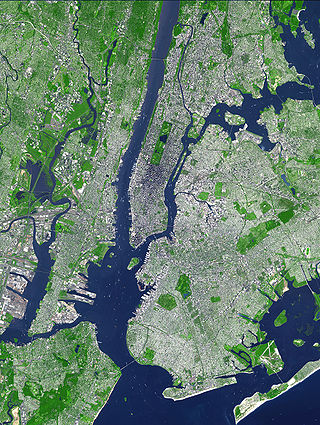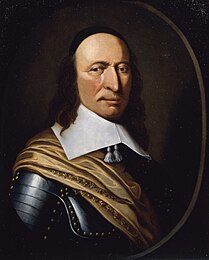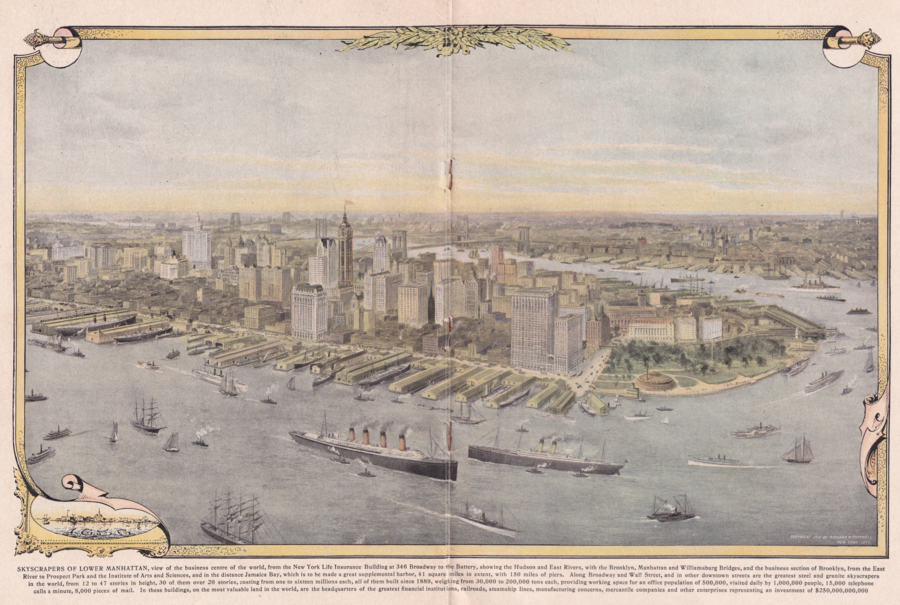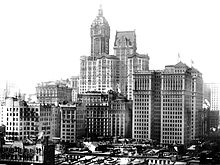
The Bronx is a borough of New York City, coextensive with Bronx County, in the U.S. state of New York. It is south of Westchester County; north and east of the New York City borough of Manhattan, across the Harlem River; and north of the New York City borough of Queens, across the East River. The Bronx is the only New York City borough not primarily located on an island. The Bronx has a land area of 42 square miles (109 km2) and a population of 1,472,654 in the 2020 census. If each borough were ranked as a city, the Bronx would rank as the ninth-most-populous in the U.S. Of the five boroughs, it has the fourth-largest area, fourth-highest population, and third-highest population density. The population density of the Bronx was 32,718.7 inhabitants per square mile (12,632.8/km2) in 2022, the third-highest population density of any county in the United States, behind Manhattan and Brooklyn. With a population that is 54.8% Hispanic as of 2020, it is the only majority-Hispanic county in the Northeastern United States and the fourth-most-populous nationwide.

Manhattan is the most densely populated and geographically smallest of the five boroughs of New York City. The borough is coextensive with New York County, the smallest county by geographical area in the U.S. state of New York. Located almost entirely on Manhattan Island near the southern tip of the state, Manhattan constitutes the geographical and demographic center of the Northeast megalopolis and the urban core of the New York metropolitan area. Manhattan serves as New York City's economic and administrative center and has been described as the cultural, financial, media, and entertainment capital of the world.

Brooklyn is a borough of New York City. Located on the westernmost end of Long Island, it is coextensive with Kings County in the U.S. state of New York. With 2,736,074 residents as of the 2020 United States census, Kings County is the most populous of the five boroughs of New York City and the most populous county in the State of New York. The population density of Brooklyn was 37,339.9 inhabitants per square mile (14,417.0/km2) in 2022, making it the second-most-densely-populated county in the United States, behind Manhattan, and it had the ninth-highest population of any county nationwide. Were Brooklyn still an independent city, it would be the fourth most populous in the U.S. after the rest of New York City, Los Angeles, and Chicago.
The history of New York City has been influenced by the prehistoric geological formation during the last glacial period of the territory that is today New York City. The area was short inhabited by the Lenape; after initial European exploration in the 17th century, the Dutch established New Amsterdam in 1624. In 1664, the British conquered the area and renamed it New York.
The history of New York City (1665–1783) began with the establishment of English rule over Dutch New Amsterdam and New Netherland. As the newly renamed City of New York and surrounding areas developed, there was a growing independent feeling among some, but the area was decidedly split in its loyalties. The site of modern New York City was the theater of the New York Campaign, a series of major battles in the early American Revolutionary War. After that, the city was under British occupation until the end of the war and was the last port British ships evacuated in 1783.
The history of New York City (1784–1854) started with the creation of the city as the capital of the United States under the Congress of the Confederation from January 11, 1785, to Autumn 1788, and then under the United States Constitution from its ratification in 1789 until moving to Philadelphia in 1790. The city grew as an economic center with the opening of the Erie Canal in 1825; the growth of its railroads added to its dominance. Tammany Hall began to grow in influence with the support of many Irish immigrants, culminating in the election of the first Tammany mayor, Fernando Wood, in 1854. The city had become the nation's most important port and financial center and competed with Boston as the center of high culture.
The history of New York City (1855–1897) started with the inauguration in 1855 of Fernando Wood as the first mayor from Tammany Hall, an institution that dominated the city throughout this period. Reforms led to the New York City Police Riot of June 1857. There was chaos during the American Civil War, with major rioting in the New York Draft Riots. The Gilded Age brought about prosperity for the city's upper classes amid the further growth of a poor immigrant working class, as well as an increasing consolidation, both economic and municipal, of what would become the five boroughs in 1898.

During the years of 1898–1945, New York City consolidated. New York City became the capital of national communications, trade, and finance, and of popular culture and high culture. More than one-fourth of the 300 largest corporations in 1920 were headquartered there.

The geography of New York City is characterized by its coastal position at the meeting of the Hudson River and the Atlantic Ocean in a naturally sheltered harbor. The city's geography, with its scarce availability of land, is a contributing factor in making New York the most densely populated major city in the United States. Environmental issues are chiefly concerned with managing this density, which also explains why New York is among the most energy-efficient and least automobile-dependent cities in the United States. The city's climate is temperate.

Fulton Street is a busy street located in Lower Manhattan in New York City. Located in the Financial District, a few blocks north of Wall Street, it runs from West Street at the site of the World Trade Center to South Street, terminating in front of the South Street Seaport. The westernmost two blocks and the easternmost block are pedestrian streets.

The flags of New York City include the flag of New York City, the respective flags of the boroughs of The Bronx, Brooklyn, Manhattan, Queens, and Staten Island, and flags of certain city departments. The city flag is a vertical tricolor in blue, white, and orange and charged in the center bar with the seal of New York City in blue. The tricolor design is derived from the flag of the Dutch Monarchy—the Prince's Flag—as used in New Amsterdam in 1625.

The Boroughs of New York City are the five major governmental districts that compose New York City. The boroughs are the Bronx, Brooklyn, Manhattan, Queens, and Staten Island. Each borough is coextensive with a respective county of the State of New York: The Bronx is Bronx County, Brooklyn is Kings County, Manhattan is New York County, Queens is Queens County, and Staten Island is Richmond County.
New York City has the largest population of Italian Americans in the United States as well as North America, many of whom inhabit ethnic enclaves in Brooklyn, the Bronx, Manhattan, Queens, and Staten Island. New York is home to the third largest Italian population outside of Italy, behind Buenos Aires, Argentina (first) and São Paulo, Brazil (second). Over 2.6 million Italians and Italian-Americans live in the greater New York metro area, with about 800,000 living within one of the five New York City boroughs. This makes Italian Americans the largest ethnic group in the New York metro area.

The history of Westchester County, a county in the state of New York, can be traced back to the founding of a settlement between the Hudson River and Long Island Sound in the 17th century. The area now known as Westchester County had seen human occupation since at least the Archaic period, but significant growth in the settlements that are now incorporated into the county did not occur until the Industrial Revolution.
The Land of the Blacks was a village settled by people of African descent north of the wall of New Amsterdam from about 1643 to 1716. It represented an economic, legal and military modus vivendi reached with the Dutch West India Company in the wake of Kieft's War. This buffer area with the native Lenape is sometimes considered the first free African settlement in North America, although the landowners had half-free status. Its name comes from descriptions in 1640s land conveyances of white-owned properties as bordering the hereditament or freehold "of the Blacks".

The land comprising New York City holds approximately 5.2 million trees and 168 different tree species, as of 2020. The New York City government, alongside an assortment of environmental organizations, actively work to plant and maintain the trees. As of 2020, New York City held 44,509 acres of urban tree canopy with 24% of its land covered in trees.
The cartography of New York City is the creation, editing, processing and printing of maps that depict the islands and mainland that now comprise New York City and its immediate environs. The earliest surviving map of the area is the Manatus Map.

Nechtanc was a Lenape settlement of the Canarsee located in what is now Two Bridges, Manhattan or the Lower East Side where the East River begins to turn north. In 1643, the settlement was the site of a massacre of Lenape people, mostly women and children, after the governor of New Netherland ordered the people killed as they slept. A simultaneous massacre occurred at Pavonia, just across the East River. The village is alternatively referred to in historical documents as Rechtauk.

The area of present-day Manhattan was originally part of Lenape territory. European settlement began with the establishment of a trading post founded by colonists from the Dutch Republic in 1624 on Lower Manhattan; the post was named New Amsterdam in 1626. The territory and its surroundings came under English control in 1664 and were renamed New York after King Charles II of England granted the lands to his brother, the Duke of York. New York, based in present-day Manhattan, served as the capital of the United States from 1785 until 1790. The Statue of Liberty in New York Harbor greeted millions of immigrants as they came to America by ship in the late 19th century and is a world symbol of the United States and its ideals of liberty and peace. Manhattan became a borough during the consolidation of New York City in 1898.


























